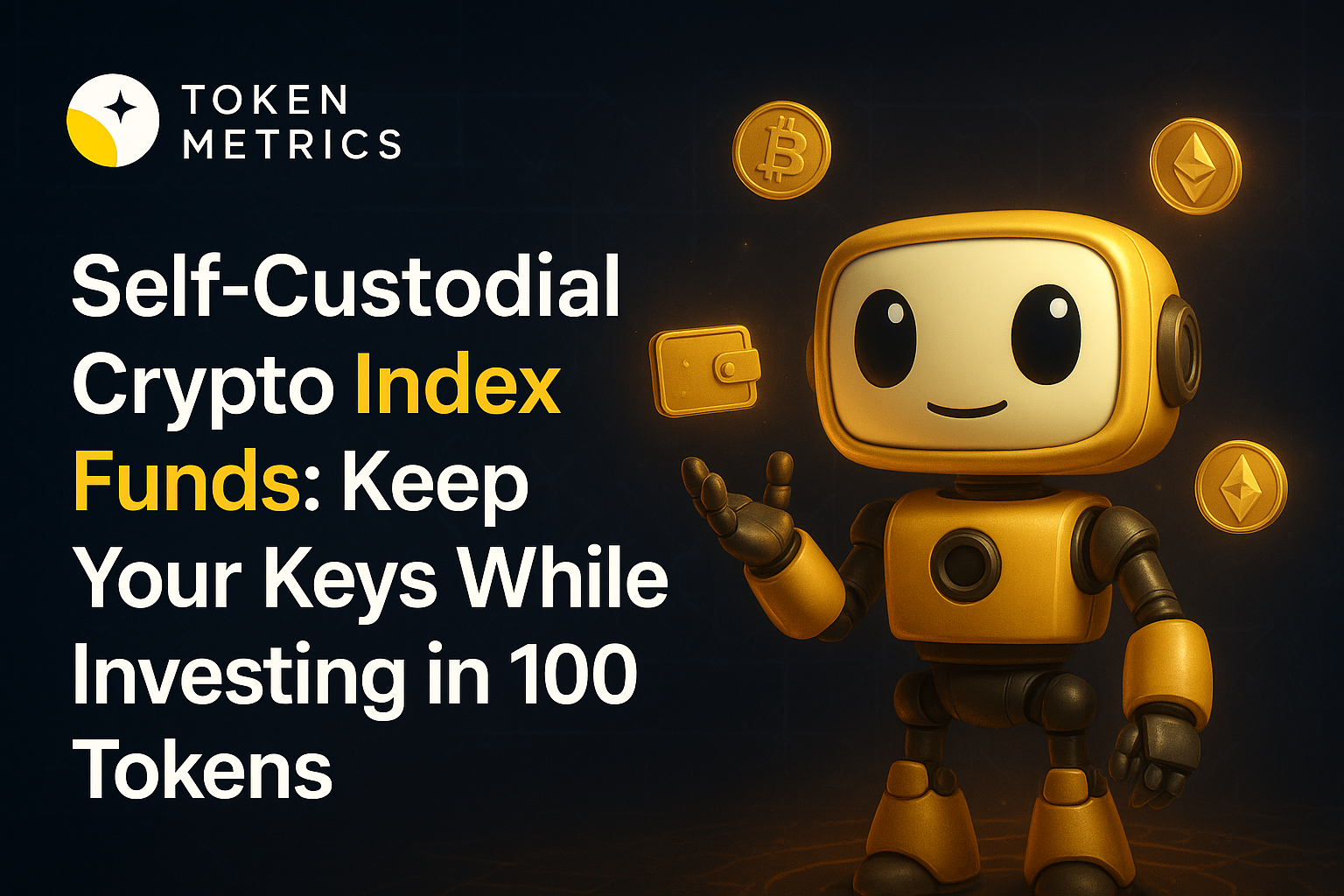
Self-Custodial Crypto Index Funds: Keep Your Keys While Investing in 100 Tokens

“Not your keys, not your crypto.” This simple mantra has echoed through the cryptocurrency world from Bitcoin’s earliest days and only grows more relevant with each high-profile exchange failure—from Mt. Gox to FTX. As we look to 2025, crypto investors face a central challenge: how to preserve the unmatched security and financial self-sovereignty of self-custody while also accessing sophisticated products like diversified crypto index funds offering exposure to over 100 tokens. The answer? A forward-looking model that merges institutional-grade portfolio techniques with uncompromised asset control: self-custodial crypto index funds.
The Custody Crisis: Why Self-Custody Matters More Than Ever
2024 underscored the urgent need for self-custody. With centralized exchanges losing over $2.2 billion in assets to hacks and operational failures, the inherent vulnerabilities of custodial models—where third parties control your private keys—have come under scrutiny. When assets are held on an exchange, users do not directly own the underlying cryptocurrency but possess a claim dependent on the exchange’s solvency and security. These intermediaries can be hacked, subject to mismanagement, or restricted by regulatory intervention, exposing investors to risks beyond their control.
Self-custody upends this paradigm. By managing a self-custodial wallet, only you possess the private keys required to access your funds. No centralized institution can impose withdrawal restrictions, freeze your holdings, or lose your assets due to oversight. This direct control embodies the core ethos of crypto: financial sovereignty.
Historically, self-custody has posed significant hurdles. Managing large, diversified portfolios—sometimes 100 tokens across multiple blockchains—demanded considerable effort, technical knowledge, and operational discipline. The complexity often pushed even security-conscious investors back toward custodial providers in search of ease and simplicity.
The Revolution: Embedded Smart Wallets Meet Index Investing
Recent technological advances have dismantled the old trade-off between security and complexity. The breakthrough is the combination of embedded smart contract wallets and fully automated index strategies. This blend enables crypto users to retain full asset ownership while accessing diversified crypto indices, simplifying the process to just a few clicks.
Embedded smart wallets are self-custodial by design, integrated into applications using secure schemes like Multi-Party Computation (MPC) and Trusted Execution Environments (TEEs). They simplify access without compromising the fundamental security benefits of self-custody. Traditional vulnerabilities—such as losing a seed phrase—are addressed using methods like key sharding, multi-factor authentication, and social recovery mechanisms, reducing single points of failure and making recovery both secure and user-friendly.
When paired with automated index investment strategies, embedded wallets let individuals invest in the top 100 cryptocurrencies while maintaining full control of their private keys. The infrastructure ensures that only the user holds custody, while smart contracts streamline investing and portfolio management without requiring technical expertise.
Token Metrics TM Global 100: Self-Custody at Scale
Token Metrics has built on these innovations with its TM Global 100 Index, which embeds wallet functionality directly into its platform. As an AI-driven crypto investment research platform, Token Metrics analyzes over 6,000 projects and uses this data for transparent and reliable index construction.
Here’s how it works:
- One-Click Onboarding: Users generate a smart contract wallet within the platform quickly, relying on familiar authentication (email, biometrics, or social sign-ins) while maintaining full asset control—no separate wallet apps or seed phrases required.
- Automatic Portfolio Execution: Upon investing, the embedded wallet acquires the top 100 tokens according to market capitalization, optimizing trade batching to minimize gas fees and slippage. All assets are deposited directly in user-controlled wallets, not in platform custody.
- Seamless Rebalancing: Portfolios are refreshed every week as market caps change, with trades executed by smart contracts. Users retain signing authority (potentially automated through pre-approved session keys) at every step, ensuring self-custodial integrity.
- Full Transparency: Token Metrics provides real-time portfolio snapshots, transaction histories with on-chain proofs, and comprehensive analytics, reinforcing trust and visibility. Users can always independently verify ownership and activity on the blockchain.
The result is a platform merging sophisticated index exposure with uncompromising asset self-sovereignty.
The Technical Foundation: How Self-Custodial Indices Work
The architecture enabling self-custodial index investing includes several key advancements:
- Smart Contract Wallets: Wallets function as programmable accounts, unlocking features like multi-signature security, spending limits, modular recoverability, and automatic execution for repetitive tasks such as weekly portfolio rebalancing.
- Session Keys and Delegated Signing: Users grant limited, clearly scoped permissions for actions (such as automated rebalancing within set parameters) without total control ever leaving their hands. These permissions can be revoked at any time.
- Modular Security: Drawing on protocols like Safe (formerly Gnosis Safe), users can add layers—such as recovery and spending limit modules—without compromising private key custody.
- On-Chain Transparency: All transactions are public, auditable, and verifiable. Investors can cross-check holdings, portfolio changes, and smart contract logic on open blockchains. This guarantees transparency and empowers users to exit the system at any point.
Ultimately, the underlying blockchain’s health supports this self-custodial infrastructure, as asset safety and protocol integrity depend on network reliability.
The Security Advantage: Why Self-Custody Wins
Self-custodial index structures offer multiple security and autonomy advantages:
- Counterparty Risk Elimination: Centralized exchanges continue to attract attacks. In self-custodial models, users’ assets are immune from exchange-specific risks.
- Regulatory Independence: Decentralized wallet architectures cannot be arbitrarily frozen or shuttered by authorities, preserving user access in varied regulatory environments.
- No Rehypothecation: Assets in self-custodial wallets are never lent out or put at further risk. There’s no risk of losing assets to mismanaged lending schemes.
- Direct Ownership: Unlike traditional brokerages, with self-custody individuals have cryptographic and audit-proof control over their wealth.
Token Metrics supports these security advantages by presenting transparent information on anticipated gas fees, platform charges, and execution parameters before every transaction—ensuring clarity with no hidden deductions.
Addressing the Challenges: Self-Custody Simplified
Historically, self-custody presented challenges:
- Lost Key Risk: Modern embedded wallets add features like social recovery and encrypted cloud backup protected by multi-factor authentication, overcoming the single point-of-failure seed phrase problem.
- Operational Complexity: Token Metrics abstracts away multi-chain management and hundreds of private keys, providing an intuitively unified portfolio view.
- Transaction Costs: Smart contract batching drastically lowers fees compared to manual trading and single-asset rebalancing.
- Inheritance and Recovery: Solutions such as recovery modules allow designated heirs to access funds under predefined conditions, addressing the problem of asset loss due to user incapacity or death.
Accurate tax compliance remains an important consideration as self-custody solutions grow in adoption and sophistication, ensuring users can report gains and losses appropriately.
Performance and Fees: What Investors Need to Know
Any assessment of crypto investing must factor in performance and costs. Index products like the Wave Select 5 Index gauge success by tracking the largest cryptocurrencies’ returns, rebalancing to capture shifting market capitalizations. Administrators adjust weightings to respond to rapid price changes, which can introduce differences in returns versus the underlying assets.
Fees are a critical variable. Management fees for crypto index products, including spot bitcoin ETFs like iShares Bitcoin Trust, range from 0.2%–1% AUM, with expense ratios reflecting greater operational complexity than many traditional funds. Over time, these expenses can significantly affect overall performance. Comparing expense ratios is essential for informed analysis.
It is also important to consider associated risks: crypto markets are volatile and direct ownership via self-custody places responsibility for security—and potential asset loss—squarely on users. Indirect exposure via ETFs or index funds may provide greater familiarity but less control and higher fees. Selecting the right exposure method depends on individual research, risk tolerance, and operational comfort.
The crypto ecosystem is dynamic, and past results do not guarantee future performance. Tax implications should be carefully assessed and, when necessary, discussed with a qualified professional.
Informed investing means understanding performance benchmarks, comparing fees, and evaluating security—without overextending financially.
The 2025 Ecosystem: Growing Infrastructure
The rise of self-custody is not limited to any single provider. The broader ecosystem is converging on these technological solutions. Fireblocks powers embedded wallet infrastructure for fintech and exchange apps, Coinbase’s Wallet-as-a-Service integrates MPC-protected self-custodial options, and Safe secures over $100 billion in institutional assets through modular smart contract wallets. Binance’s Web3 Wallet also applies MPC and embedded solutions for mainstream audiences. Even traditional banks, such as Citi, are exploring crypto custody models—highlighting industry-wide recognition of self-custody’s importance.
The shift means self-custodial investing is no longer a specialist’s tool—it is becoming standard industry practice. Unlike brokerage-based accounts, which pool assets with custodians, self-custody ensures direct asset ownership and operational control by users themselves.
Token Metrics' Comprehensive Advantage
What sets Token Metrics apart in the self-custodial index space?
- AI-Powered Curation: Not every top 100 token deserves a position. Token Metrics’ Trader and Investor Grades filter assets for momentum and fundamental strength, aiming to include quality crypto assets over speculative entries.
- Regime-Switching Protection: The TM Global 100 proactively shifts to USDC stablecoins during negative trends, preserving capital—all while keeping assets in user-controlled, self-custodial wallets.
- Comprehensive Analytics: Institutional-grade research and screening across thousands of tokens inform the methodology, helping distinguish true innovation from short-term trends.
- End-to-End Integration: From research and execution to monitoring, Token Metrics’ vertically integrated approach streamlines self-custodial index management within a unified, transparent ecosystem.
Regulated investment frameworks, like the Investment Company Act of 1940, generally require third-party custody in traditional ETFs or ETPs. In contrast, self-custodial index models empower users with full asset possession and control at all times.
The Future: Self-Custody as Standard
Every exchange incident, regulatory intervention, or centralized hack reaffirms the value of self-custody. As user and institutional adoption grows, self-custodial index solutions deliver the blend of security and sophistication the crypto market needs. This approach preserves crypto’s core values—sovereignty, censorship resistance, and transparency—while embedding the professionalism expected of modern investment products.
The Token Metrics TM Global 100 Index—combining embedded smart wallets, AI-powered analytics, and automated investment management—points to a future where exposure to hundreds of assets is easily accessible while never relinquishing control of your keys.
Conclusion: Your Keys, Your Crypto, Your Index
The self-custodial index fund is a compelling new standard: it fuses broad market access with unimpeachable personal ownership. As the ecosystem matures through 2025, platforms that blend usability with full sovereignty will shape the next era of digital asset investing.
Token Metrics demonstrates that you can retain your keys and simultaneously participate in sophisticated index strategies tracking 100 tokens—all within a single, secure, and user-friendly platform.
The mantra remains unchanged: "Not your keys, not your crypto." Now, that ethos is compatible with professional-grade investing. Welcome to self-custodial crypto index funds—where you control both security and strategy.
Click here to get early access to TM100 indices at Token Metrics.
Discover Crypto Gems with Token Metrics AI
Token Metrics uses AI-powered analysis to help you uncover profitable opportunities in the crypto market. Get Started For Free
FAQs
How does a self-custodial crypto index fund differ from a traditional index fund?
Self-custodial crypto index funds allow users to maintain full control of their assets and private keys, unlike traditional funds, where assets are held by a third-party custodian. This model leverages smart contract wallets and automated infrastructure to combine the benefits of self-custody with diversified index exposure.
What are embedded smart wallets, and how do they improve security?
Embedded smart wallets are self-custodial wallets built directly into crypto platforms or applications. They use advanced cryptographic techniques such as Multi-Party Computation (MPC) and secure key sharding to reduce single points of failure, enable smooth recovery options, and eliminate the risks associated with seed phrase storage.
Can I transfer my assets out of a self-custodial index platform at any time?
Yes. Because you retain control of the private keys in a self-custodial structure, you can revoke smart contract permissions and withdraw or transfer your assets as you choose, subject to network or gas fees.
What risks should I consider when choosing self-custody for crypto investing?
While self-custody eliminates exchange and custodial counterparty risk, it places responsibility for key management and safe recovery directly on the user. Security hygiene, responsible backup practices, and consideration of inheritance or loss scenarios are all crucial factors. Additionally, tax compliance is an important aspect to manage.
What is regime-switching in crypto index funds?
Regime-switching refers to a risk management technique where, during defined bearish market conditions, an index fund automatically shifts portfolio allocations from risk assets to stablecoins. In Token Metrics’ TM Global 100, this occurs within the user’s self-custodial wallet for added security and stability.
Disclaimer
This post is for informational and educational purposes only and does not constitute financial, investment, or legal advice. Cryptocurrency investments carry risk. Always conduct your own research and consult a qualified advisor before making investment decisions.

.svg)

Create Your Free Token Metrics Account

.png)




%201.svg)
%201.svg)


%201.svg)










.svg)




.png)